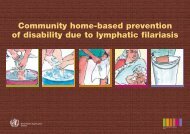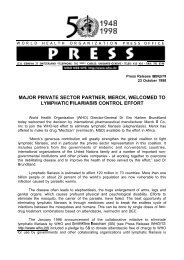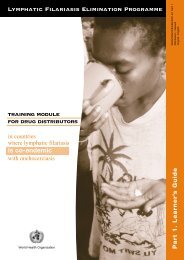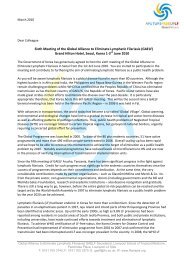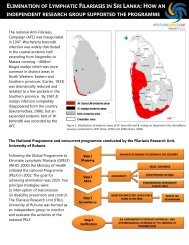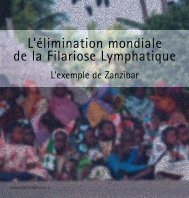Global Programme to Eliminate Lymphatic Filariasis ... - libdoc.who.int
Global Programme to Eliminate Lymphatic Filariasis ... - libdoc.who.int
Global Programme to Eliminate Lymphatic Filariasis ... - libdoc.who.int
Create successful ePaper yourself
Turn your PDF publications into a flip-book with our unique Google optimized e-Paper software.
12Annual Report on <strong>Lymphatic</strong> <strong>Filariasis</strong> 2003Chapter 1 Progress of the <strong>Global</strong> <strong>Programme</strong> <strong>to</strong> <strong>Eliminate</strong> <strong>Lymphatic</strong> <strong>Filariasis</strong>reactions in a sub-population of 1000–2000 individuals<strong>who</strong> are generally representative of the population <strong>to</strong>be covered. Such moni<strong>to</strong>ring consisted of <strong>int</strong>erviews onday 5, day 6 or day 7 after treatment <strong>to</strong> elicit whether ornot side-effects were experienced after the drugs weretaken. A standard questionnaire was designed <strong>to</strong> recordadverse reactions in individuals <strong>who</strong> had ingested theco-administered drugs during MDA. The type of adversereaction and its severity was recorded. Data from 13 programmesin 12 countries were analysed. Out of the 27912 respondents, 18 081 <strong>to</strong>ok DEC plus albendazole and9831 <strong>to</strong>ok ivermectin plus albendazole in the first roundof MDA. Of the respondents, 25.6% reported an adversereaction after taking the drugs (26.5% <strong>who</strong> had takenDEC plus albendazole and 24% <strong>who</strong> had taken ivermectinplus albendazole). However, in only 3.5% (5.4% in theDEC plus albendazole group and 1.4% in the ivermectinplus albendazole group) was the adverse reaction of suchseverity that they were unable <strong>to</strong> function normally <strong>int</strong>heir daily activities of going <strong>to</strong> work or school. The mostcommon adverse reactions in the DEC plus albendazolegroup were dizziness, headache, nausea and fatigue; <strong>int</strong>he ivermectin plus albendazole group they were headache,jo<strong>int</strong> or muscular pains, nausea and abdominalpain.In February 2003, the WHO Safety Review Committee,consisting of programme staff and external and <strong>int</strong>ernalexperts on drug safety, reviewed the use of the combineddrugs. Based on the data collected, the committee came<strong>to</strong> the following conclusions and recommendations,which were endorsed by TAG-LF at its fourth meetingin March 2003.• After reviewing the findings of the active surveillancefollowing single exposure <strong>to</strong> co-administered drugs in27 912 individuals (18 081 received DEC and albendazole,while 9831 received ivermectin and albendazoleco-administrations), the committee concluded thatthe frequency and <strong>int</strong>ensity of the reported reactionswere in line with previously documented reactions.• Based on this finding, the committee decided thatthere was no need <strong>to</strong> continue with the active surveillancefor side-effects. Furthermore, because of thenature of the reactions observed, the committee didnot expect significant changes in the pattern and frequencyof these particular adverse reactions in subsequentexposure <strong>to</strong> the drugs.• The committee recommended that in future the focusshould be on the identification and management ofidiosyncratic reactions <strong>to</strong> the drugs, and in particular<strong>to</strong> the serious adverse experiences (SAEs) followingdrug administration. <strong>Programme</strong> managers shouldbe instructed <strong>to</strong> report any such reactions.• An SAE is defined as an adverse experience followingtreatment with a drug that results in any of the following:— death;— life-threatening condition;— in-patient hospitalization or prolongation of anexisting hospitalization;— persistent or significant disability or incapacity;— congenital anomaly or birth defect;— cancer;— overdose (accidental or <strong>int</strong>entional).Important medical events not resulting in death or a lifethreateningcondition or requiring hospitalization maybe considered SAEs when, based upon appropriate medicaljudgement, they jeopardize the patient or subject andmay require medical or surgical <strong>int</strong>ervention <strong>to</strong> preven<strong>to</strong>ne of the outcomes listed in the above definition; suchevents should also be reported.The report of an SAE should be handled with utmosturgency and should initially be taken care of according<strong>to</strong> local regulations before immediate forwarding <strong>to</strong>WHO by the national programme manager.• The committee reinforced TAG-LF’s recommendations<strong>to</strong>:— encourage programme managers <strong>to</strong> be vigilant andreport pregnant women <strong>who</strong> are excluded fromdrug exposure during MDA;— use the last menstrual period as an appropriatemeasure <strong>to</strong> prevent drug administration <strong>to</strong> pregnantwomen during MDA campaigns.Based on the review of the status of the national programmesand the materials presented, there was noobvious cause for concern about the continuation and



